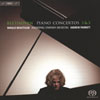Beethoven Piano Concertos Nos 3 & 6
Disaster strikes Beethoven while other performances fail to ignite
View record and artist detailsRecord and Artist Details
Genre:
Orchestral
Label: Telarc
Magazine Review Date: 13/2008
Media Format: CD or Download
Media Runtime: 0
Mastering:
Stereo
Catalogue Number: 2CD80704

Composer or Director: Ludwig van Beethoven
Genre:
Orchestral
Label: Alpha
Magazine Review Date: 13/2008
Media Format: CD or Download
Media Runtime: 0
Mastering:
Stereo
DDD
Catalogue Number: ALPHA122

Tracks:
| Composition | Artist Credit |
|---|---|
| Concerto for Piano and Orchestra No. 3 |
Ludwig van Beethoven, Composer
Arthur Schoonderwoerd, Piano Cristofori Ludwig van Beethoven, Composer |
| Concerto for Piano and Orchestra |
Ludwig van Beethoven, Composer
Arthur Schoonderwoerd, Piano Cristofori Ludwig van Beethoven, Composer |
Composer or Director: Ludwig van Beethoven
Genre:
Orchestral
Label: BIS
Magazine Review Date: 13/2008
Media Format: Super Audio CD
Media Runtime: 0
Mastering:
Stereo
DDD
Catalogue Number: BISSACD1692

Tracks:
| Composition | Artist Credit |
|---|---|
| Concerto for Piano and Orchestra No. 1 |
Ludwig van Beethoven, Composer
Andrew Parrott, Conductor Ludwig van Beethoven, Composer Norrköping Symphony Orchestra Ronald Brautigam, Piano |
| Concerto for Piano and Orchestra No. 3 |
Ludwig van Beethoven, Composer
Andrew Parrott, Conductor Ludwig van Beethoven, Composer Norrköping Symphony Orchestra Ronald Brautigam, Piano |
Author: Nalen Anthoni
No need to question the beliefs of Ronald Brautigam and Andrew Parrott in the First Concerto. Parrott doesn’t make “gestures” to the Norrköping musicians. He conducts them – with distinction too, grounding the music in a strong bass-line, placing the notes where he wants them to be within an elastic pulse, and keeping the phrase structures airborne. Violins are separated, and the basic tempo for the first movement is close to Czerny’s prescribed figure of crotchet=176. It’s a fair clip but here far from hasty; and the jolting F natural on the piano (rather than the usual F sharp) at 4'19" suggests that Hans-Werner Köthen’s edition was used. Brautigam also makes Beethoven’s long third cadenza sound improvised. A deeply felt Largo (excellent clarinets) and finale that is perhaps a touch too fast – but, again, no haste – rounds off an imposing performance.
Similar tempi for the outer movements of the Third Concerto are, however, misconceived. The scherzando style so successful in the First is unsuitable for this work, its gravity diminished by a two-in-a-bar speed for the first movement (as was marked in now discredited texts) and by a lightweight scamper of the last. Timpani could be better defined but otherwise the instrumental balance is right and SACD sound very good indeed.
John O’Conor settles on four-in-a-bar, a traditional choice for the first movement of the First and an appropriate one for the corresponding movement of the Third. In fact his tempi everywhere cannot be faulted but his performances fail to ignite. They are cautious and earthbound, not least because Andreas Delfs is a negative partner. His conducting (or lack of it) mires a bored LSO in rhythmic inertia that hamstrings O’Conor too. There is little or no sense of direction, no vibrantly expectant inevitability. You’ll find those qualities in the complete sets by Aimard/Harnoncourt (Teldec, 4/03) Brendel/Rattle (Philips, 5/99) and Schiff/Haitink (Teldec, 9/97 – nla).
Discover the world's largest classical music catalogue with Presto Music.

Gramophone Digital Club
- Digital Edition
- Digital Archive
- Reviews Database
- Full website access
From £8.75 / month
Subscribe
Gramophone Full Club
- Print Edition
- Digital Edition
- Digital Archive
- Reviews Database
- Full website access
From £11.00 / month
Subscribe
If you are a library, university or other organisation that would be interested in an institutional subscription to Gramophone please click here for further information.





